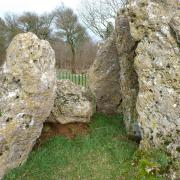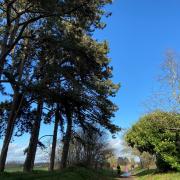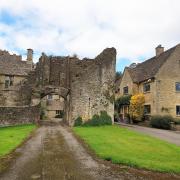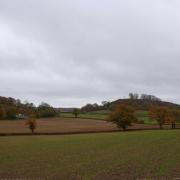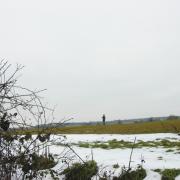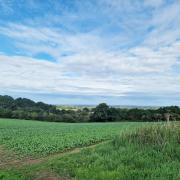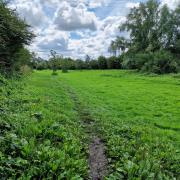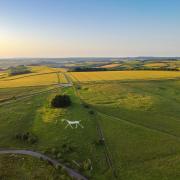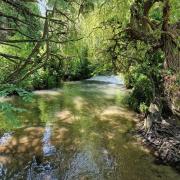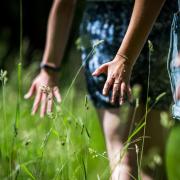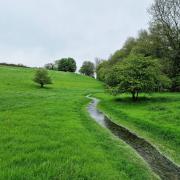Dark deeds at Browne’s Folly? Ghosts on the A363? And who was Sally in the Wood?
Today’s walk starts from the village of Bathford, just east of Bath. It takes us through the woods around Browne’s Folly, down to the infamous stretch of road called ‘Sally in the Wood’, then back up a pleasant lane to Bathford once more. From Church Street, head up Pump Lane to the edge of the village. Walk up a patch of green above Mountain Wood Road, climb the stile on the right, and go diagonally across the field and into Browne’s Folly Wood. Immediately, you’re in another world – of beech, birch, and limestone. A Bathford resident told us that the name ‘Sally in the Wood’ is said to come from Royalist soldiers ‘sallying’ through en route to the Battle of Lansdowne in 1643. As we’ll see, there are many other interpretations of this name.

As you head uphill to Browne’s Folly, bearing left when the path divides, you’ll notice outcrops of exposed rock. This area was once a major site for quarrying the high-quality limestone known as Bath Stone. There have been quarries here since Roman times. Bath Stone is an oolitic limestone laid down in warm Jurassic seas during a particular interval of time, 168 to 166 million years ago, to which it gives its name: the Bathonian.
The path takes you over a stile and past one of the quarries – we saw goats grazing there – and then up to the Folly. This tower was built for the quarry owner, Captain Wade Browne, in 1848. A staircase runs up the inside, and there used to be wonderful views from the top, but today there’s no railing – so please don’t risk going up! Browne said he built the Folly to provide work for his quarrymen in slack periods. But is that really the truth?

Once upon a time, a man was told that his daughter was going to die on a certain day. He loved his daughter dearly and didn’t want her to die. So he had this tower built and he locked up his daughter inside it. Food was sent up to her once a day and she would lower the empty plates back down. But on the day her father had been told she’d die the plates did not come down. Her father rushed up the tower’s stairs – only to find his daughter lying dead on the floor, bitten by a snake. Her ghost is said to haunt the woods all the way down to the road. Is she the Sally in the Wood?

From the Folly, follow the path south along the top of the escarpment. The quarry workings you’ll see around you are today home to no less than eight species of bat, thanks to the efforts of Avon Wildlife Trust. But were the woods once also home to human denizens? Some that say the Folly was built not to confine someone but as a watchtower from which a worried father could keep an eye on his little girl as she played in the woods. The woods had their dangers, but she loved to play amidst the bluebells and garlic, and her father knew that so long as he could see her she’d be safe. She grew into almost a young woman. Her father had got very busy and couldn’t always go up the tower to keep watch, but he knew she was sensible. Then one day she didn’t come home. They searched and searched, but no sign of her was found. Her father was convinced she’d been taken by the Gypsies who camped in the woods; his workers were sure she’d fallen into a mine. In this tale, too, the girl’s ghost began to haunt the wood. Is this the Sally in the Wood? Yet other tales tell of a Gypsy girl who starved to death in the tower. Was she Sally?

The woodland path leads down to the part of the A363 known as ‘Sally in the Wood’. Time and again along here drivers have screeched to halt when someone has stepped out in front of the car – only to find that no one was there. Or their car has inexplicably stopped – and in the rear-view mirror they’ve seen a figure standing in the road behind them. Some accounts speak of glimpsing someone in the passenger seat; one person said they’d driven all the way home with the car’s interior light on!

You too need to take care here, since you have to walk a short way along the left-hand side of the road; keep to the footpath worn behind the verge marker posts. Just before a bridge, take the footpath to the left, and then turn right under the dry arch into another stretch of woodland. Here, perhaps, we discover the ‘real’ Sally. Near the arch, on this side of the road, there used to be a wooden hut, once a gamekeeper’s hut, which became the home of Sally Gibson, the widow of one of the gamekeepers. When her husband died in 1783, Sally had to leave her house, since it was tied to his job. With no money and nowhere to go, she went to the hut in the woods and set up home there, near a spring. The other gamekeepers did look out for her, but Sally was a power to be reckoned with. She sold refreshments to travellers after the turnpike was built in 1795, and got carters to bring things she needed from the villages. Woe betide them if they forgot: their horses would simply stop at the point on the road nearest to her hut and refuse to go on! Sally stayed there for 41 years. She was two months off her 100th birthday when she died.

The rumours about Sally began while she was alive. An old woman living alone in the woods, surely she had to be a witch? Someone even reported seeing something come out of her chimney on a broomstick. But it sounds as though Sally made the spot a haven for wildlife. The hart’s tongue ferns you now see everywhere in the woods grew only around her hut in those days, and her patch was awash with snowdrops, wood anemones, bluebells, and early purple orchids.
Bear right, over the stone slab stile, and head down through the wood to a minor road and the hamlet of Warleigh. From here you could once take a ferry across to Warleigh Weir, now a popular swimming spot, and proceed along the Kennet and Avon Canal towpath. Sadly, this is no longer possible, but you can take a detour down to see the weir. Otherwise, head northwards back along the lane through the woods and fields to Bathford. There’s a reminder of the ancient past along the way: at Warleigh Lodge Farm a farm road that cuts across to the A363 sits on the line of the Wansdyke, which possibly was used here as a road by the Romans.

Back in Pump Lane, take the snicket on the left to St Swithin’s Church, whose tombs remind us of the layers of history and story that even a small village can accrue. There are many Sallys in the Wood, tales born of the rustling trees, the tall tower, the shadowy road. But at the heart of all that is a simple human story of a strong woman making the best of difficult circumstances. She’d be as pleased as punch to know she’s still remembered in the name of the road near where she lived.
ESSENTIALS
Distance: 4 miles.
Duration: 2.5 hours.
Level: Moderate walking with a number of stiles and some steep inclines.
Parking: Road parking in Bathford.
Toilets and refreshments: The Crown and the Shop and Café, in Bathford.
Transport links: FirstBus No. 3 from Bath serves Bathford.
Map: OS Explorer 155: Bristol and Bath.
LINKS
Route: gb.mapometer.com/walking/route_5335907
Browne’s Folly Nature Reserve: avonwildlifetrust.org.uk/nature-reserves/brownes-folly
Sally Gibson: bit.ly/35roNbB
Kirsty Hartsiotis and Anthony Nanson are based in Stroud and available for hire as storytellers and speakers. Their books include Gloucestershire Folk Tales, Wiltshire Folk Tales, Gloucestershire Ghost Tales, and Gloucestershire Folk Tales for Children. Kirsty is also the curator of decorative and fine art at a Gloucestershire museum. Anthony runs the small press Awen Publications.




